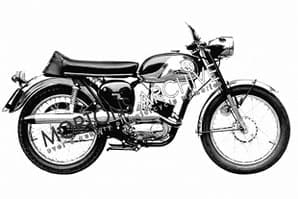
Made from 1948 until 1971, there were over 400,000 Bantams built, with many riders taking their first two-wheeled outings on the little BSA. That’s one of the reasons why it has remained so well loved, when allied to its general ruggedness and cheeky charm. Still a great starter classic, for club runs and such, it takes some beating.
Rider’s view
Having just completed a 120 mile club run on a D10 Sports, I can only say that it’s a pleasure to ride. Headwinds are a slight pain, but otherwise the little BSA is a joy on British backroads and well capable of surprising – and impressing – riders on more ‘prestigious’ machines.
Enjoy more Classic MotorCycle reading in the monthly magazine.
Click here to subscribe & save.
Key model years and descriptions follow.
1950 BSA Bantam D1
The original and, so far as many are concerned, the best. Thing is though that the 123cc three-speed machine feels incredibly slow in modern conditions, though it has bucketloads of charm. Launched in June 1948, it was clearly based upon the DKW RT125; but of all the ‘copies’ (by the likes of Harley-Davidson and Royal Enfield, among others) it was the one with the most changes and development.
1958 BSA Bantam D5
When the decision was made to upgrade the Bantam’s engine capacity, 150cc was decided upon, as it kept it in a cheap tax bracket. To start with there was a plunger frame, but this was swapped for a swinging arm job, the same frame which would go on to be used for the D5. The D3 Major was launched for the 1954 season, with the increase in capacity achieved by a larger bore. The 175cc D5 came in 1958.
1962 BSA Bantam D7
Although it used the same 175cc engine as its predecessor, the D5, the D7 was the first ‘modern’ Bantam in that it ‘looked’ like a bigger bike. This was achieved with a new rear frame, side-panels and a cover hiding the rear downtube. A headlamp nacelle was added too, as well as new fork. The D7 was to be built for seven years but by now, Bantam production was a fraction of the D1 days.
1966 BSA Bantam D10 Sports
The standard D10, which came in mid-1966, had something like 40% more power than the D7. The D10 Sports offered even more, having a four-speed gearbox and the new Amal Concentric carburettor. It also looked the part too, with its upswept exhaust, humped seat and flyscreen. Top speed was just over 60mph (not much more than even the old D5) but it looked faster and the extra cog made it all so much easier.
1968 BSA Bantam D14/4
Promises of ‘over 60mph’ and ‘at least 100mpg’ were among the boasts made of the D14/4, which now had a compression ratio of 10:1 and a claimed 14bhp. Despite its advantages, the D14/4 was being left behind at an increasing pace by its Japanese rivals. While they now had automatic oiling, five (or six) speed gearboxes, bigger brakes and so on, the Bantam carried on as before. It was cheap, though.
1970 BSA B75 Bushman
The Bushman was in many ways a ground-breaking machine, probably the first ‘dual purpose’ (later, ‘trail bike’) listed by a major manufacturer. Popular in Africa for its toughness, the majority of all Bushmen built (about 3500) went aboard, only around 300 staying at home. Its gearing limits top speed to a touch over 50mph on the road.
Visit the Mortons Archive for more information and online search options concerning Nortons, or speak to our archivist Jane Skayman on 01507 529423 with your requirements. Email [email protected] ![]()
Other articles in the 'which model' series:
? Ariel Square Fours
? BSAs
? BSA A10s
? Cammy Norton Singles
? Norton Commando
? Norton ES2
? Triumph Thunderbird
? Velocette LE
Advert
 Enjoy more The Classic MotorCycle reading in the monthly magazine. Click here to subscribe.
Enjoy more The Classic MotorCycle reading in the monthly magazine. Click here to subscribe.



